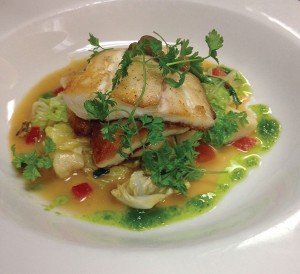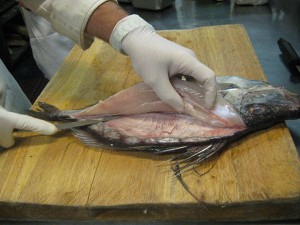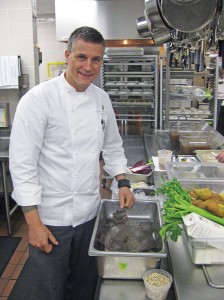by RHETT REGISTER
“Save for picnics and occasional dinners, we existed almost entirely on the riches of the rivers and the sea,” wrote James Beard in his 1964 book, Delights and Prejudices describing his childhood spent fishing, crabbing and collecting shellfish on the Oregon coast.
Called “the dean of American cuisine” by his friend and fellow epicure Julia Child, Beard was a powerful voice for American fine food from the 1940s until his death in 1985. He pioneered cooking shows on television, wrote books and taught a gospel of “fresh and local” that he first learned during those seafood-filled summers on the beach in Gearhart.
Often referred to as the Oscars of the culinary world, the James Beard Foundation Awards honor people and businesses in the food industry that exemplify the characteristics that Beard promoted during his life.
This year, North Carolina had 13 semifinalists and has one finalist for the awards. Like Beard, many North Carolina contenders feel a strong connection to the shore and to fresh, local seafood.
ACTING LOCALLY
“We love North Carolina seafood,” says Raleigh chef and restaurateur Ashley Christensen, one of five finalists for Best Chef: Southeast, an area that includes Georgia, Kentucky, the Carolinas, Tennessee and West Virginia.

Pan-roasted coastal flounder at Nana’s in Durham. Photo by Heather Mallory.
She is especially a fan of live blue crabs. “We make stocks and soups out of the whole crab,” she says. “Our favorite this year was a North Carolina she-crab bisque with local butternut squash and sherry.”
The sheepshead, a black-and-white striped North Carolina species with snaggled, jutting teeth, is another she prefers. “This ugly little critter has become a house favorite with its sweet and tender meat,” Christensen says. “We pan roast it with brown butter and thyme, and serve it over Sea Island red peas and Carolina Gold rice, among other preparations.”
Christensen, whose roster of Raleigh restaurants includes Poole’s Diner, is not alone in her efforts to feature local fish and shellfish.
Vivian Howard, a semifinalist for Best Chef: Southeast, owns and operates the Chef & The Farmer in Kinston with her husband, Benjamin Knight. Six years ago, the couple moved from New York to Howard’s native Lenoir County with the goal of opening a restaurant that focuses on local food, including seafood. “I do love North Carolina clams, softshell crabs and bluefish,” she says.
While a restaurant housed in what they describe as a “100-year-old mule stable across from the county farmer’s market in downtown Kinston” might not be the first place that one would think of as a fine-dining destination, reviewers rave about Howard’s inspired take on traditional southern fare — including revisiting common North Carolina fish like speckled trout, bluefish and mullet.
“This fall we harvested the roe from lots of jumping mullets and dried it, making our own Bottarga,” she says of the salty delicacy. “The idea of turning people on to something they once deemed undesirable is very exciting to me.”
FOCUS ON FISH
“Not only do we use N.C. seafood — it’s our focus,” exclaims Scott Howell, head chef and owner of Nana’s in Durham. Howell, who was a semifinalist for Best Chef: Southeast, mentions triggerfish as a favorite.
“When I was working in New York I discovered how fantastic but also how expensive John Dory was,” he says. “When I moved back down here, I found that there’s an incredible similarity between John Dory and triggerfish, but triggerfish is a whole lot less expensive. And it’s local.”
Nana’s February menu offered triggerfish, “grilled over couscous with cherry tomatoes and Cipollini onions in a braised octopus broth with fennel and red peppers.”
Howell also calls out North Carolina vermillion snapper and red grouper. He featured the snapper on the February menu “pan roasted over Brinkley Farms field peas and baby bok choy finished with wild mushrooms.”
Nana’s March menu has the grouper “pan roasted over cannellini beans with braised leeks and savoy cabbage finished in a lemon-caper sauce.”
Down the road in Cary, Scott Crawford, executive chef of five-star Herons restaurant, and also a semifinalist for Best Chef: Southeast, likes local grouper of another type: snowy grouper.
“It seems like it has more fat and, you know, fat equals flavor. Grouper is a pretty lean fish but it’s got just enough to make it buttery. I like to poach it — a real gentle poach — whereas the other groupers, I like to pan roast. We really like to baby that snowy grouper,” he says.
BUMPY ROAD
That North Carolina has 13 semifinalists this year compared to nine last year and seven five years ago speaks to the state’s growth as a culinary destination. With that comes a desire for more seafood both in quantity and type. But getting local seafood to the large inland market has been difficult at times.
“For the first three years or so, we struggled to get North Carolina seafood here,” recalls Howard. “Our plumber used to pick it up at the coast and deliver it to us.”
Now Chef & The Farmer gets its seafood from Fishtowne, out of Beaufort, and Inland Seafood. But having difficulties finding fresh, high-quality North Carolina seafood has been a problem for many of the semifinalists.
“There’s a lot of challenges,” says Andrea Reusing, who won Best Chef: Southeast in 2011 and whose Chapel Hill restaurant, Lantern, was a semifinalist for Outstanding Restaurant this year. “I think that much of the North Carolina seafood that we end up using in the restaurant goes up to New York to the Fulton Fish Market before we ever see it.”
Howell is even more blunt, “I think they ought to stop letting people take all our tuna to New York. And our black bass, by god! Our tuna and our black bass, let us keep some of it down here in North Carolina,” he says.

A John Dory, which has a flavor similar to triggerfish, is filleted at Nana’s. Photo by Rhett Register.
Barry Nash, North Carolina Sea Grant seafood technology and marketing specialist understands the challenges. “For years North Carolina suppliers have been selling to wholesale markets from Virginia to Boston because they’re big auction houses that accept fresh product. Since these markets tend to pay more, fishermen and processors can often receive higher prices for local seafood than in North Carolina,” he says.
Nash is currently working with the N.C. Rural Economic Development Center and with North Carolina State University colleagues to design supply chains that will make local seafood more available within the state.
Besides looking at the need for distribution centers, Nash also assists the industry with commercializing new products, manufacturing needs, and evaluating business models and opportunities that could increase the flow of North Carolina seafood inland.
It is the latter that Aaron Vandemark, another semifinalist for Best Chef: Southeast, is most interested in. His Hillsborough restaurant, Panciuto, offers Italian-inspired food using Southern ingredients. “The issue for me is my desire to work with the fishermen, not the second, third or fourth reseller in the system that gets the fish to me,” he explains.
It’s the same with meats and produce. “I speak with my farmers every week and we talk about availability. Then they bring or I pick up the product. That’s an ideal relationship for me. That’s how I’d be privy to the amazing catch our coast has to offer,” he says.
RECIPES
Here are a few recipes that some of this year’s James Beard Foundation Awards North Carolina semifinalists use in their restaurants.
Andrea Reusing (Lantern)
Salt-and-Pepper Shrimp
Serves 6
• 1 1/2 pounds medium fresh shrimp in shell
• 3 quarts corn oil
• 3 tablespoon plus 1 teaspoon kosher salt
• 2 large egg whites, at room temperature for 30 minutes
• 1 cup cornstarch
• 3 tablespoons plus 1 teaspoon freshly ground black pepper
• 2 cups sliced jalapeño peppers, sliced into 1/8-inch thin rounds
• 3 cups cilantro sprigs (from 2 bunches)
• flaky sea salt, such as Maldon, to taste
Cut the shell along the back of each shrimp with small kitchen shears and devein, then snip off the legs. Do not peel.
Heat the oil to 400 F in an 8- to 10-quart heavy pot.
While the oil is heating, toss the shrimp with 1 tablespoon of the salt and let stand for 5 minutes. Rinse with cold water, then drain well and pat them dry.
Pulse the egg whites in a blender for a few seconds until watery, then transfer them to a large bowl.
In another large bowl, stir together the cornstarch, 3 tablespoons of pepper and 2 tablespoons of salt.
Toss half of the shrimp with 1/2 teaspoon of salt and 1/2 teaspoon of pepper in a third bowl. Use a slotted spoon to dip them in egg white, let excess drip off, then dredge the shrimp in the cornstarch mixture, shaking off any excess. You are looking for a very light coating, or else the shrimp will not be very crispy. Carefully slide the shrimp into the hot oil and cook for 1 1/2 to 2 minutes until they are crisp and cooked through. Use a slotted spoon to transfer the cooked shrimp to paper towels.
Season, coat and cook the rest of the shrimp. Keep cooked shrimp in a warm place.
Reduce the oil temperature to 375 F.
Put half of the chiles in the oil, wait 10 seconds and add half of the cilantro until the cilantro just starts to turn dark green and the chiles are wilted, no more than 30 seconds. Do not let the chiles or cilantro brown. Transfer with a slotted spoon to paper towels. The cilantro will get cripsy only after it cools off.
Let the oil temperature get back to 375 F. Now repeat this process with the rest of the chiles and cilantro. Scatter the chiles and cilantro over the shrimp and season liberally with sea salt. Serve immediately.
Scott Howell (Nana’s)
Pan-Seared Flounder with Wild Mushrooms
Serves 2
Flounder is a great gift of the North Carolina coast. It’s a mild, white fish that is packed with healthy omega-3 fatty acid and B vitamins and is especially popular with people who don’t like “fishy” fish. Plus, it’s available year round in North Carolina, so it’s a good bet you can still find fresh flounder when other fish have been shut down for the season.
• 1 10-ounce flounder skinless fillet
• 1/4 cup oyster mushrooms, pulled to bite-sized pieces
• 2 tablespoon dry sherry (or dry white wine)
• 1/4 cup chicken stock
• 1 tablespoon chopped fresh thyme, chopped fresh sage or a combination of the two
• 2 to 3 tablespoons peanut oil
• 1 to 2 tablespoons olive oil
• 1 tablespoon plus 1 teaspoon of butter
• 1 chopped shallot
• Wondra flour (rice flour or fine corn meal if gluten-free)
• fine sea salt
• black pepper
Dry fillet thoroughly and place on paper towels.
Mushroom Preparation: Place a small skillet over medium-high heat. When hot, cover the bottom of the pan with a 50-50 combination of peanut and olive oil. Add the oyster mushrooms, stirring and coating them so they brown evenly. Add chopped shallots, salt, pepper and 1 tablespoon of butter and continue to stir the mixture. Remove from heat once shallots have released their aroma and set aside.
Place another pan (choose one large enough to easily hold the fish) over medium-high heat. When hot, add 2 tablespoons peanut oil (or enough to cover the bottom of the pan).
Pat fillet with fresh paper towels and lightly dust with Wondra flour. Season with salt and pepper and place dry fillet into the pan. Reduce the heat to medium and cook for approximately 3 minutes or until the bottom half of the thick side has turned white. Before flipping the fish (use a flexible fish spatula), add the remaining teaspoon of butter and jiggle the pan to ease the turn. Once the fish has been flipped, baste it with the pan liquid and add herbs. Cook for approximately 3 more minutes. Try to cook the fish for the same time on each side so that both sides are an even golden brown, rather than one dark side and one light side. Carefully remove fish from pan to a platter. Tent with foil while completing the mushroom preparation.
As soon as fish is out, remove excess fat and add the cooked mushroom and shallot mixture to the pan. Deglaze with the sherry and add enough chicken stock to cover mushrooms. Bring the mixture back to a light boil, add 2 teaspoons olive oil and reduce to desired consistency. Season to taste if needed before spooning over fillet. Serve immediately.
Howell’s variation for the pro: To create maximum mushroom flavor, replace sherry and chicken stock with fresh mushroom stock. To make the stock, combine 1 pound of white button mushrooms with a gallon of water and bring to a boil. Simmer for two hours, strain the mixture (discarding the mushrooms) and reduce by half.
Buying Note: When buying flounder whole, you want to choose a fish that is firm to the touch and whose scales are intact. Look for eyes that are clearish (rather than cloudy). For this recipe, you’ll want a jumbo flounder fillet, so try to get the largest flounder you can, and if you don’t plan to clean it yourself, ask the fishmonger to fillet it for you.
Aaron Vandemark (Panciuto)
Green Tomato Brodetto

Aaron Vandemark at Panciuto uses Southern ingredients to create Italian-inspired fare. Photo by Brian Brough.
This is a nice sauce at the bottom of a bowl of clams with crusty grilled bread.
• 3 tennis-ball sized green tomatoes, rough chopped
• 2 teaspoons jalapeño pickles (or 1 teaspoon jalapeño peppers, finely chopped)
• 2 teaspoons jalapeño pickle juice (optional)
• 3 tablespoons simple syrup (heated and then chilled sugar and water mixed in a 2:1 ratio) and 1 tablespoon white vinegar, mixed
• 1/2 cup diced onions or scallions
• 1/4 cup white wine
• 1 1/2 cup clam juice
• 1/4 cup cream to help bind
Sweat onions/scallions in olive oil to soften, but don’t brown them. Add white wine and simmer it away. Add clam juice and turn off the heat. In a food processor, blend tomatoes, jalapeño pickles and simple syrup mixture. Add clam juice/onion mixture and continue to blend. Transfer mixture to a blender and buzz to liquefy completely. Strain over a pot or bowl, pressing out all of the solids to extract all of the liquid. Discard solids and stir cream into green tomato Brodetto. Check seasoning, adding salt or pepper as needed.
To find out more about the James Beard Foundation Awards visit: www.jamesbeard.org. Winners will be announced May 6.
Look in an upcoming issue of Coastwatch for articles that explore the N.C. Rural Center project, and other issues affecting North Carolina’s seafood supply chain that are being addressed in a collaborative project funded by the U.S. Department of Agriculture.
2013 North Carolina James Beard Foundation Award Semifinalists |
| Award Category | Owner and/or Chef | Restaurant | Location |
| Best New Restaurant | Matthew Kelly | Mateo Tapas | Durham |
| Outstanding Restaurant | Andrea Reusing | Lantern | Chapel Hill |
| Rising Star Chef of the Year | Katie Button | Cúrate | Asheville |
| Best Chef: Southeast Named “Nominee” March 18 |
Ashley Christensen | Poole’s Diner | Raleigh |
| Best Chef: Southeast | Vivian Howard | Chef & The Farmer | Kinston |
| Best Chef: Southeast | Scott Howell | Nana’s | Durham |
| Best Chef: Southeast | Elliott Moss | The Admiral | Asheville |
| Best Chef: Southeast | Aaron Vandemark | Panciuto | Hillsborough |
| Best Chef: Southeast | Scott Crawford | Herons at the Umstead Hotel and Spa |
Cary |
| Outstanding Pastry Chef | Phoebe Lawless | Scratch | Durham |
| Outstanding Wine Program | Angus Barn | Raleigh | |
| Outstanding Wine, Spirits, or Beer Professional |
Eric Solomon | Eric Solomon Selections European Cellars | Charlotte |
| Outstanding Wine, Spirits, or Beer Professional |
Sean Lilly Wilson | Fullsteam | Durham |
This article was published in the Spring 2013 issue of Coastwatch.
For contact information and reprint requests, visit ncseagrant.ncsu.edu/coastwatch/contact/.

